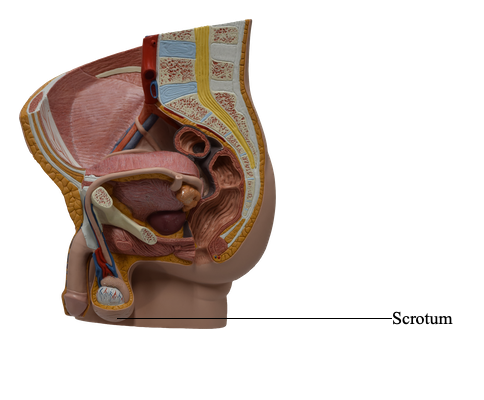Main Model

Scrotum

Scrotum
The scrotum is a cutaneous sac consisting of two layers: heavily pigmented skin and the closely related dartos fascia, a fat-free fascial layer including smooth muscle fibers (dartos muscle) responsible for the rugose (wrinkled) appearance of the scrotum. Because the dartos muscle attaches to the skin, its contraction causes the scrotum to wrinkle when cold, thickening the integumentary layer while reducing scrotal surface area and assisting the cremaster muscles in holding the testes closer to the body, all of which reduces heat loss.
The scrotum is divided internally by a continuation of the dartos fascia, the septum of the scrotum, into right and left compartments. The septum is demarcated externally by the scrotal raphe, a cutaneous ridge marking the line of fusion of the embryonic labioscrotal swellings. The superficial dartos fascia is devoid of fat and is continuous anteriorly with the membranous layer of subcutaneous tissue of the abdomen (Scarpa fascia) and posteriorly with the membranous layer of subcutaneous tissue of the perineum (Colles fascia).
The development of the scrotum is closely related to the formation of the inguinal canals. The scrotum develops from the labioscrotal swellings, two cutaneous outpouchings of the anterior abdominal wall that fuse to form a pendulous cutaneous pouch. Late in the fetal period, the testes and spermatic cords enter the scrotum.
The arterial supply of the scrotum is from the:
• Posterior scrotal branches of the perineal artery: a branch of the internal pudendal artery.
• Anterior scrotal branches of the deep external pudendal artery: a branch of the femoral artery.
• Cremasteric artery: a branch of the inferior epigastric artery.
Scrotal veins accompany the arteries.
The lymphatic vessels of the scrotum drain into the superficial inguinal lymph nodes.
The nerves of the scrotum include branches of the lumbar plexus to the anterolateral surface, and branches of the sacral plexus to the posterior and inferior surfaces:
• Genital branch of the genitofemoral nerve (L1, L2): supplying the anterolateral surface.
• Anterior scrotal nerves: branches of the ilio-inguinal nerve (L1) supplying the anterior surface.
• Posterior scrotal nerves: branches of the perineal branch of the pudendal nerve (S2-S4) supplying the posterior surface.
• Perineal branches of the posterior cutaneous nerve of thigh (S2, S3): supplying the postero-inferior surface.